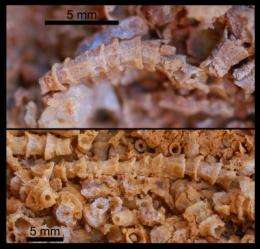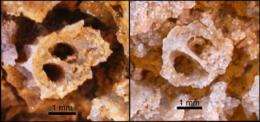A new fossil species found in Spain

In the '80s, Spanish researchers found the first fossils of Cloudina in Spain, a small fossil of tubular appearance and one of the first animals that developed an external skeleton between 550 and 543 million years ago. Now palaeontologists from the University of Extremadura have discovered a new species, Cloudina carinata, the fossil of which has preserved its tridimensional shape.
"Cloudina carinata is characterised by its elaborate ornamentation and complexity of the shells and tube that are formed when inserted", Iván Cortijo, main author and researcher in the Area of Palaeontology at the University of Extremadura, describes to SINC.
The study, which was recently published in Precambrian Research, describes various specimens of the new species. These fossils show evidence of asexual reproduction, until now "only described in Chinese specimens of Cloudina", and are "one of the oldest examples of reproduction in animals in the fossil register", maintains the researcher from Extremadura.
The fossils have been found in the archaeological site El Membrillar (Badajoz), one of the few sites in Europe where remains of Cloudina can be found. "The specimens display exceptional preservation, they appear preserved in three dimensions, and show their original form and numerous details of the shells", Cortijo points out.
The discovery of new species of Cloudina is important "for understanding the early evolution of animals", states Cortijo, who adds that "its importance for understanding the origin of skeletons is indisputable". Despite the fact that its relation to other groups of animals is uncertain, Cloudina has been compared to cnidaria (medusas and corals) and annelida (polychaeta sea worms, earthworms and leeches).

According to the research team, the study of fossils from the Ediacaran period (between 630 and 540 million years ago) and of other fossils from the early Cambrian (540 million years ago) reveals the path followed by evolution at a crucial moment in the history of life, when the first animals appeared. This first evolutionary radiation of animals reached its apex in the so-called "great Cambrian explosion" or "Big-Bang of evolution".
In search of Cloudina
In the '70s specimens of Cloudina were discovered for the first time in Namibia and later they were discovered in Oman, southern China and the south-east of the USA. According to scientists, it is a fossil indicative of the terminal Ediacaran, which marks the end of the Proterozoic eon, and gives way to the Phanerozoic, when the great radiation of animals began.
In Spain Cloudina was discovered in the '80s thanks to Teodoro Palacios, director of the research group Palaeontology and Stratigraphy of the Neoproterozoic and Palaeozoic at the University of Extremadura.
More information: Cortijo, I.; Marti Mus, M.; Jensen, S.: Palacios, T. "A new species of Cloudina from the terminal Ediacaran of Spain" Precambrian Research 176(1-4): 1-10 Jan 2010.
Provided by FECYT - Spanish Foundation for Science and Technology



















